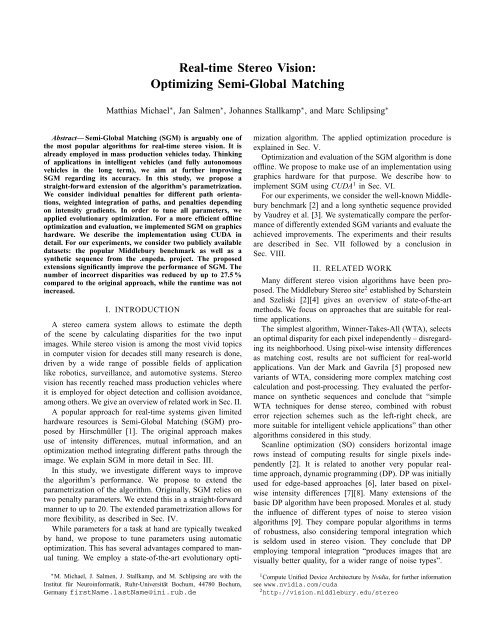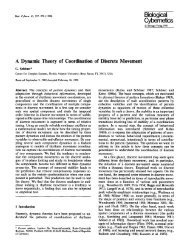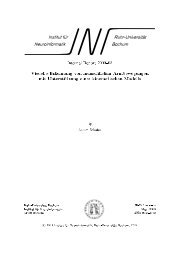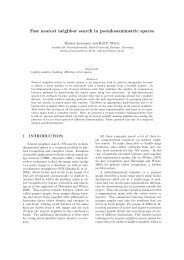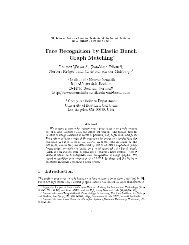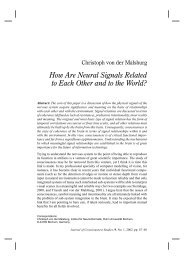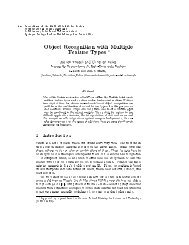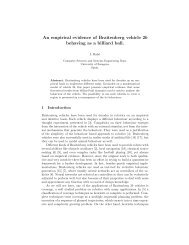Real-time Stereo Vision: Optimizing Semi-Global Matching
Real-time Stereo Vision: Optimizing Semi-Global Matching
Real-time Stereo Vision: Optimizing Semi-Global Matching
Create successful ePaper yourself
Turn your PDF publications into a flip-book with our unique Google optimized e-Paper software.
<strong>Real</strong>-<strong>time</strong> <strong>Stereo</strong> <strong>Vision</strong>:<strong>Optimizing</strong> <strong>Semi</strong>-<strong>Global</strong> <strong>Matching</strong>Matthias Michael ∗ , Jan Salmen ∗ , Johannes Stallkamp ∗ , and Marc Schlipsing ∗Abstract— <strong>Semi</strong>-<strong>Global</strong> <strong>Matching</strong> (SGM) is arguably one ofthe most popular algorithms for real-<strong>time</strong> stereo vision. It isalready employed in mass production vehicles today. Thinkingof applications in intelligent vehicles (and fully autonomousvehicles in the long term), we aim at further improvingSGM regarding its accuracy. In this study, we propose astraight-forward extension of the algorithm’s parametrization.We consider individual penalties for different path orientations,weighted integration of paths, and penalties dependingon intensity gradients. In order to tune all parameters, weapplied evolutionary optimization. For a more efficient offlineoptimization and evaluation, we implemented SGM on graphicshardware. We describe the implementation using CUDA indetail. For our experiments, we consider two publicly availabledatasets: the popular Middlebury benchmark as well as asynthetic sequence from the .enpeda. project. The proposedextensions significantly improve the performance of SGM. Thenumber of incorrect disparities was reduced by up to 27.5 %compared to the original approach, while the run<strong>time</strong> was notincreased.I. INTRODUCTIONA stereo camera system allows to estimate the depthof the scene by calculating disparities for the two inputimages. While stereo vision is among the most vivid topicsin computer vision for decades still many research is done,driven by a wide range of possible fields of applicationlike robotics, surveillance, and automotive systems. <strong>Stereo</strong>vision has recently reached mass production vehicles whereit is employed for object detection and collision avoidance,among others. We give an overview of related work in Sec. II.A popular approach for real-<strong>time</strong> systems given limitedhardware resources is <strong>Semi</strong>-<strong>Global</strong> <strong>Matching</strong> (SGM) proposedby Hirschmüller [1]. The original approach makesuse of intensity differences, mutual information, and anoptimization method integrating different paths through theimage. We explain SGM in more detail in Sec. III.In this study, we investigate different ways to improvethe algorithm’s performance. We propose to extend theparametrization of the algorithm. Originally, SGM relies ontwo penalty parameters. We extend this in a straight-forwardmanner to up to 20. The extended parametrization allows formore flexibility, as described in Sec. IV.While parameters for a task at hand are typically tweakedby hand, we propose to tune parameters using automaticoptimization. This has several advantages compared to manualtuning. We employ a state-of-the-art evolutionary opti-∗ M. Michael, J. Salmen, J. Stallkamp, and M. Schlipsing are with theInstitut für Neuroinformatik, Ruhr-Universität Bochum, 44780 Bochum,Germany firstName.lastName@ini.rub.demization algorithm. The applied optimization procedure isexplained in Sec. V.Optimization and evaluation of the SGM algorithm is doneoffline. We propose to make use of an implementation usinggraphics hardware for that purpose. We describe how toimplement SGM using CUDA 1 in Sec. VI.For our experiments, we consider the well-known Middleburybenchmark [2] and a long synthetic sequence providedby Vaudrey et al. [3]. We systematically compare the performanceof differently extended SGM variants and evaluate theachieved improvements. The experiments and their resultsare described in Sec. VII followed by a conclusion inSec. VIII.II. RELATED WORKMany different stereo vision algorithms have been proposed.The Middlebury <strong>Stereo</strong> site 2 established by Scharsteinand Szeliski [2][4] gives an overview of state-of-the-artmethods. We focus on approaches that are suitable for real<strong>time</strong>applications.The simplest algorithm, Winner-Takes-All (WTA), selectsan optimal disparity for each pixel independently – disregardingits neighborhood. Using pixel-wise intensity differencesas matching cost, results are not sufficient for real-worldapplications. Van der Mark and Gavrila [5] proposed newvariants of WTA, considering more complex matching costcalculation and post-processing. They evaluated the performanceon synthetic sequences and conclude that “simpleWTA techniques for dense stereo, combined with robusterror rejection schemes such as the left-right check, aremore suitable for intelligent vehicle applications” than otheralgorithms considered in this study.Scanline optimization (SO) considers horizontal imagerows instead of computing results for single pixels independently[2]. It is related to another very popular real<strong>time</strong>approach, dynamic programming (DP). DP was initiallyused for edge-based approaches [6], later based on pixelwiseintensity differences [7][8]. Many extensions of thebasic DP algorithm have been proposed. Morales et al. studythe influence of different types of noise to stereo visionalgorithms [9]. They compare popular algorithms in termsof robustness, also considering temporal integration whichis seldom used in stereo vision. They conclude that DPemploying temporal integration “produces images that arevisually better quality, for a wider range of noise types”.1 Compute Unified Device Architecture by Nvidia, for further informationsee www.nvidia.com/cuda2 http://vision.middlebury.edu/stereo
In addition to algorithms considering single pixels orscanlines, approaches that perform global optimization havebeen proposed. They consider measures across the wholeimage. Such algorithms, e. g., belief propagation (BP), allowfor high accuracy on the one hand. On the other hand, theyare computationally more demanding than local methods.<strong>Semi</strong>-global matching (SGM) approximates a global optimizationby combining several local optimization steps.We describe SGM in detail in the next section. Kletteet al. [10] recently published an extensive comparison ofdifferent stereo algorithms including variants of DP, BP, andSGM. In their summary, they state that “SGM can potentiallydeal with scenes of high-depth complexities”. The algorithmperformed en par with DP and BP in their overall results.A few extensions and modifications to the original SGMalgorithm have already been proposed: In [11] improvementsfor structured environments are achieved by employing anadditional segmentation step. Hermann et al. [12] show thatthe run<strong>time</strong> of SGM can be significantly reduced while theaccuracy is only slightly affected. Implementing SGM ongraphics hardware has been discussed, we refer to relatedwork in Sec. VI where we describe our CUDA implementation.III. SEMI-GLOBAL MATCHINGAs already introduced in the last section, current stereoalgorithms can be divided into two major groups: local andglobal methods. Local methods try to find optimal disparitiesfor small image regions – e. g., a single row – which can leadto discontinuities between different regions (for instance,the well-known streaking effects in DP). <strong>Global</strong> approachesoptimize all disparities at once and, thus, achieve an overallbetter performance. However, the required computation <strong>time</strong>is considerably higher.The SGM – as a semi-global method – incorporates theadvantages of both groups, achieving relatively low complexityand relatively high quality. It can be broken down intothree distinct phases which will be briefly explained below.Given the maximum disparity d max and rectified imagepairs, for each pixel at position (x,y) in the base image,the corresponding pixel in the match image is bound to liebetween(x,y) and(x−d max ,y) (assuming that the left imageis chosen as base image). The chosen disparities d are ratedby a cost function likeC(d) = |I b (x,y)−I m (x−d,y)|, (1)which just computes the absolute difference of gray levelsgiven a certain pixel at position (x,y) in the base image I band pixel (x−d,y) in the match image I m . There are severalreasonable cost functions for the matching. Beside taking theabsolute difference of gray levels, Hirschmüller proposes amethod based on mutual information to incorporate illuminationchanges between both input images [1].The objective function E(D) from Eq. (2), which assignscosts to a disparity image D, has to be minimized in orderto achieve optimal disparities.⎛E(D) = ∑ ⎝C(d)+ ∑d∈D+ ∑d ′′ ∈N(d)d ′ ∈N(d)P 1 T[|d−d ′ | = 1]⎞P 2 T[|d−d ′′ | > 1] ⎠, (2)where T[·] = 1 if its argument is true and 0 otherwise, andN(d) denotes d’s neighborhood. The function sums the initialcosts C(d) for the chosen disparities and two additionalpenalties which depend on the difference to the neighborhooddisparities. If they differ by 1, a small penalty P 1 is applied.For larger differences, P 2 is added. The choice of a smallerP 1 allows to adapt to slanted or tilted surfaces. Bigger jumpsin disparity are only possible if C(d ′′ )−C(d) > P 2 .Minimizing E(D) in a two-dimensional manner wouldbe very costly. Therefore, SGM simplifies the optimizationby traversing one-dimensional paths and ensures theconstraints with respect to these explicit directions. Thisapproach requires a second phase known as cost aggregation.Equation (3) describes this procedure for a horizontal pathfrom the left to the right in an arbitrary image row y.E(x,y,d) =C(x,y,d)+min[E(x−1,y,d),E(x−1,y,d−1)+P 1 , (3)E(x−1,y,d+1)+P 1 ,mini(E(x−1,y,i)+P 2 ) ]E(x,y,d), which is recursive, defines a second cost measureassigned to each pixel at a certain position (x,y) withdisparity value d. Therefore, the cost for a single pixelrequires all cost values of preceding pixels. This allows tocompute the costs via path traversal from the left to the right.This traversal effectively emulates the constraints introducedby the original objective function E(D). A pixel maybe assigned a lower cost if it adapts its disparity to itsneighbors. However, this only holds for one direction and,thus, several differently oriented paths have to be executed.According to [1], the minimum number of paths should be atleast 8 (i. e., two paths for the horizontal, vertical and bothdiagonal orientations respectively).The final (smoothed) costs for each pixel and each disparityS(x,y,d) are obtained by summing the costs E r (x,y,d)of paths in all directions r:S(x,y,d) = ∑ rE r (x,y,d) (4)The final step finds the disparity that minimizes the costfor each pixel given S. With the described method, a disparityis assigned to every pixel of the base image – regardlessof occlusions. However, there exist certain methods to refinethe disparity values.Occlusion detection is achieved by additionally computingdisparities for the match image followed by pixel-wise con-
sistency check. If disparities differ, the corresponding valuein the original image is regarded invalid.A rather simple refinement of the disparities can beobtained by filtering the disparity image with a small medianfilter. Thereby single outliers are removed and the edges inthe image may be enhanced. Lastly, a sub-pixel estimationcan be realized by fitting a quadratic curve through the lowestcost value and its two neighboring disparities. This may shiftthe actual minimum by a value smaller 1 and, therefore,increase disparity resolution.IV. EXTENDED PARAMETRIZATIONAs stated in Sec. III, SGM originally requires only twoparameters – the matching penalties that are used for everypath. It is possible to calculate a disparity image based ona single path. Comparing the results of different paths, oneis able to observe major differences in quality, depending onthe global structure of the input images.Fig. 1. Disparity images based on the horizontally and vertically orientedpaths with P 1 = 15 and P 2 = 35.One example of this behavior are images containing streetsurfaces as shown in Fig. 1. The horizontally oriented pathsallow to compute a good disparity image. The vertical orientations,however, show a large amount of streaking. This ismainly caused by the ground plane featuring disparities thatmonotonously change in vertical directions. The algorithmfavors regions of constant disparities (due to the penalties inEq. (2)) and, therefore, causes a large amount of errors.In the scenario shown in Fig. 1, the penalties are wellchosen for the horizontal paths, whereas the vertical pathswould benefit from smaller penalties supporting a largerdeviation in neighboring disparities. Therefore, we allow forindividual P 1 (r) and P 2 (r) for each path depending on itsdirection r.Regardless of the choice of penalties, the results obtainedfrom a certain path orientation may still lead to betterestimates than the results from other orientations. Hence,it should be possible to alter its contribution to the finaldisparity image, which is achieved by introducing weightsfor each path orientation. We extend Eq. (4) in the followingway, introducing w r :S(x,y,d) = ∑ w r ·E r (x,y,d). (5)rNote that for both extensions proposed above, only thepath orientation (e. g., horizontal, vertical, etc.) should haveimpact on the parameters. We disregard the particular sequence(e. g., left to right or right to left) and assign the samepenalties and weights to paths sharing the same orientation.For instance, all parameters for horizontal paths from left toright and right to left are set identically although the pathshave different directions r given the notation above.Finally, it is well-known that stereo vision can benefit fromadapting penalties for disparity discontinuities dependingon the actual image content. For this reason, Hirschmüllerproposes to adapt P 2 depending on the intensity gradientI ∆ (x,y) for each pixel considered at position (x,y). Wefollow this suggestion in a more general way by introducingadditional penalties ˆP 1 (r) and ˆP 2 (r) that are used at(x,y) if I ∆ (x,y) exceeds a fixed threshold instead of P 1 (r)and P 2 (r), respectively.The presented SGM extensions incorporate a number ofup to five parameters for each considered orientation: fourpenalties and one weight. Given that the minimum numberof orientations is four, this yields 20 parameters for ourfully extended SGM. Tuning such an amount of parametersshould not be done manually. An automated optimization isfavorable and is explained in the following section.V. AUTOMATIC OPTIMIZATIONThe SGM variants proposed here rely on up to 20 parameters.For tuning such high numbers of parameters, a largeamount of data has to be considered. These are commoncircumstances in computer vision and optimizing parametersis often done manually in a more or less systematic way.We argue that the task of finding optimal parametersfor given training data should be automated. There arepowerful and well established methods available, for instanceevolutionary algorithms. Automatic optimization, comparedto manual tuning, has several benefits: It can consider a largeamount of data, handle many parameters and in particulartheir complex interplay. It is <strong>time</strong>-saving, is unbiased andimpartial, and it assures to find (near-)optimal solutions.For the problem at hand, we can interpret all parametersas real-valued. This allows to use the covariance matrixadaptation evolution strategy (CMA-ES), which represents“the state-of-the-art in evolutionary optimization in realvaluedR n search spaces” [13]. Like other evolutionaryalgorithms, CMA-ES performs optimization by iterativelyadapting solutions. However, in contrast to other approaches,it also adapts its search distribution during the evolution,allowing for faster convergence. For more details, see [14].In order to apply CMA-ES, one has to assign a qualitymeasure (fitness) to each generated parameter combination(individual). For the given problem, this can be done bycomputing disparity images for the proposed parameters andevaluating their correctness with respect to ground-truth.VI. CUDA IMPLEMENTATIONImplementing SGM using graphics hardware has alreadybeen discusses. Rosenberg et al. [15] make use of Cg shaders.Ernst and Hirschmüller [16] describe an implementationusing OpenCL, but they state that “since CUDA offers moreflexibility and higher abstraction from the graphics hardware,we are going to implement SGM in CUDA”. In [17] Zhu
et al. described their CUDA implementation resulting in areasonable speed-up. Here, we present our approach.Since the required operations are very <strong>time</strong>-consuming,classical CPU implementations are not real-<strong>time</strong> capable.Moreover, in order to optimize parameters with an evolutionaryalgorithm several thousand iterations are necessary. Thus,a highly efficient implementation of SGM would speed-upoptimization and support real-<strong>time</strong> execution.Many of the involved tasks are completely independent ofeach other, e. g., the intensity-based calculation of the initialcosts of the original SGM. Also, the path traversal – in whicheach step depends on the previous one – can be parallelizedto a certain degree, by executing several paths at the same<strong>time</strong>. Therefore, the overall performance of the algorithmcan profit from parallel execution. Due to a recent popularityof programmable GPGPUs (General Purpose GraphicsProcessing Units) in off-the-shelf consumer hardware, wechose CUDA technology for our implementation, whichallows programming graphics hardware in C with extensionsfor parallel functions, data transfer, and explicit caching(cf.[18]).CUDA follows a SIMD (Single Instruction Multiple Data)execution model enabling the programmer to frame a computationaltask (kernel) that is performed in the same manner onsmall chunks of data. These tasks are assigned to lightweightthreads executed on the graphics hardware in parallel. Thethreads of a kernel function are organized in a two-levelhierarchical structure with up to three dimensions. The gridis divided into several blocks holding the threads. Generally,each thread is assigned data (e. g., a single pixel of an image)depending on its location within the grid / block.Another important aspect of CUDA is the memory management.The use of different kinds of memory is mostlynecessary to achieve high performance. In the following, thestructural design of our implementation is described.To manage access to the CUDA part of the code thehost functions are encapsulated in traditional C++ classesthat execute calls to the CUDA-API. Since SGM can bedivided into three distinct phases, initial cost calculation, costaccumulation, and disparity estimation, one kernel functionimplements the main work of the particular task.Initial cost calculation: The calculation of pixel-wiseinitial matching costs can be parallelized in the most straightforward manner. The rectified left and right image are copiedto GPU memory and serve as input to this stage. Thedesignated output is a w × h × d max cost matrix C, wherew and h denote width and height of the input images, andd max is the chosen maximal disparity. Each matrix entry canbe computed independently according to Eq. 1.Thus, for each entry of C, a single thread is launched.Those perform the lookup in both input images and calculatethe absolute difference of grey levels and thereby eliminatethe need for synchronization between different threads mentionedin [17]. As mentioned above the created kernel gridhas the same dimensionality as C. Both images are boundto texture memory, which offers implicit two-dimensionalcaching for read accesses and, thus, increases performance.Moreover, textures offer very efficient border handling foraccesses outside the defined coordinates.Path traversal: Based on C, Eq. (3) is implementedby traversing paths in eight directions across the disparityimage and accumulating the results in a path matrix E of thesame size. Since one path step depends on its predecessors,parallelization is constrained. However, different paths ofthe same direction can be executed at the same <strong>time</strong>. Thestraightforward implementation would invoke a single threadto calculate an entire path considering all possible disparities.This is improved by separating a path into d max threads,each of them responsible for a single disparity value. Sincethe minimum of all preceding disparities is determined, allcalculations of the previous path step have to be completed.This is assured by CUDAs kernel synchronization mechanism( syncthreads()), which stops further executionuntil all threads of a block have reached this statement. Thus– and in contrast to [17] – all threads responsible for the samepath are grouped in a block. At the same <strong>time</strong>, this allowsfor using shared memory, which is shared across a block, forhanding over intermediate results of the previous path step.Thereby no information has to be transmitted between differentblocks. The minimum is calculated using a reductiontechnique which is popular in parallel computing [18].Is is noteworthy that the calculation of differently orientedpaths is achieved by modifying starting point andstep direction, i. e., coordinate in- or decrement which isdone by utilizing device function pointers. To increase codemaintainability, a single kernel function was implemented forthat purpose. Depending on the parameters this kernel canefficiently traverse arbitrary paths across the image.Disparity Estimation: The final step is to determinethe optimal disparity d of from E for each pixel (x,y).Again this can be done separately for each pixel by applyingan extension of the before-mentioned reduction technique.Naturally reduction is used to calculate the overall minimalvalue. Here it is necessary to determine the disparity thatcorresponds to this minimum. Therefore, instead of one,two arrays in the shared memory are required from whichone holds the computed minima while the other containsthe original disparity of the value. Both arrays are updatedsimultaneously.This implementation only requires log 2 (d max ) steps tocompute the optimal disparity for each pixel. It is noteworthy,that at this point some mismatch can arise between ourimplementation and an otherwise equivalent single-threadedone. If several potential minima with the same cost valueexist, the reduction is prone to select one in the middle of thearray, while a typical iterative approach most likely selectsthe first or the last minimum it encounters.Extensions: Since most of the here proposed extensionsconsist of additional parameters the general implementationdescribed above does not need to be changed. The additionalpenalties as well as the weights can be simply transferred tothe GPU and used as input to the path kernel. The gradientimage was calculated beforehand and copied to the GPU aswell. During each step of the path traversal a lookup to this
TABLE ISGM ALGORITHM VARIANTS CONSIDERED FOR OUR EXPERIMENTS.Algorithmorientationdependentpenaltiespathsweightsgradientdependentpenalties#param1. SGM – – – 22. SGM ∆ – – + 43. SGM ⃗w – + – 64. SGM ∠ + – – 85. SGM ∆,⃗w – + + 86. SGM ⃗w,∠ + + – 127. SGM ∆,∠ + – + 168. SGM ∆,⃗w,∠ + + + 20image is necessary to determine which penalty (e. g., P 1 orˆP 1 ) has to be applied. However, all threads in a block willbranch the same way in a certain path step and, therefore,do not suffer from a slow down.VII. EXPERIMENTSIn order to evaluate the accuracy improvements providedby the proposed modifications of SGM, we compare differentvariants on two datasets. The experimental setup (Sec. VII-A) and results (Sec. VII-B) are documented in this section.A. SetupWe evaluated SGM variants using eight paths (i. e.,four orientations) which is the minimum according to [1].Individual penalties can be applied for each path orientation,denoted with an additional symbol ⃗w. We considered variantsusing weights for integration of path results, denoted as ∠.Finally, we investigated the influence of penalties dependingon image gradients, denoted as ∆. See Tab. I for an overviewof the eight different algorithm variants considered. The totalnumber of parameters differs from 2 (baseline algorithm) to20 (applying all extensions proposed here).All SGM variants were implemented using CUDA (seeSec. VI). Experiments were conducted on a four-core IntelXeon W3520 PC equipped with a Nvidia Geforce GTX 480.Fig. 2. Images from the datasets considered: Middlebury benchmark (left)and synthetic sequence (right).We performed parameter optimization for all approachesindependently. The popular Middlebury benchmark datasetas well as a synthetic sequence made publicly available byVaudrey et al. [3] were used. Figure 2 shows examples fromboth data sources. For the Middlebury benchmark, trainingand evaluation was performed on all four image pairs. Fromthe simulated sequence, the first 100 frames were used fortraining and the remaining 296 frames for evaluation. Sinceconsecutive images show little variance we only consideredevery tenth frame.As cost function, we employed pixel-wise intensity differences,see Eq. (1). Mutual information was not considered,as the used images do not have any brightness differences.We did not apply post-processing in order to evaluate theperformance of the raw algorithms.In order to evaluate the quality of disparity images comparedto ground-truth, we considered the root mean squarederror (RMSE) as well as the number of bad pixels. Thelatter (using a threshold of 1) was used for fitness assignmentto solutions during evolutionary optimization (see Sec. V).However, depending on the target application, one mightchoose another fitness to ensure correct results especiallyfor objects close to the viewer or for object borders.Five optimization trials were conducted for each algorithmvariant. Parameters were initialized randomly for each run.We assured P 1 < P 2 for all starting points. Nevertheless, wedid not enforce this constraint during optimization. We usedthe CMA-ES implementation from the Shark 3 open-sourcemachine learning library [19].B. ResultsTable II shows the results of different SGM variants onthe Middlebury dataset. The best performance was achievedwith the SGM ∆,⃗w,∠ resulting in 4.1 % bad pixels, which is27.5 % less than for the original SGM.Table III shows results for the synthetic sequence. Notethat testing was performed on a different part than traininghere, so the results allow to evaluate the generalization error.Our fully extended SGM performed best on the training setagain. However, for the test set, the best result was achievedby an other new variant which applied individual weightsand penalties for each orientation. Here an improvement of15.1 % was obtained compared to the original approach.VIII. CONCLUSION<strong>Semi</strong>-global matching (SGM) is a popular algorithm forreal-<strong>time</strong> stereo vision, for instance, in the context of intelligentvehicles. In this study, we investigated three approachesto extend the algorithm’s parameter set in order to improvethe accuracy of SGM.Firstly, SGM can benefit from discriminating the consideredpaths by introducing individual penalties. Secondly, weproposed to introduce weights for the integration of paths.Thirdly, we investigated penalties that adapt to discontinuitiesdetected in the input images.In order to tune the algorithm’s parameters, evolutionaryoptimization was employed. Among other advantages, thisassures an unbiased evaluation. We provided results for thepopular Middlebury benchmark dataset as well as for asynthetic sequence.In order to allow for a more efficient optimization, weimplemented SGM using CUDA. Our implementation runs3 http://shark-project.sourceforge.net
TABLE IIRESULTS ON THE MIDDLEBURY BENCHMARK.Algorithm P1 1 P21 Pˆ11 Pˆ2 1 P1 2 P22 Pˆ12 Pˆ2 2 P1 3 P23 Pˆ13 Pˆ2 3 P1 4 P24 Pˆ14 Pˆ2 4 ⃗w 1 ⃗w 2 ⃗w 3 ⃗w 4 Error1. SGM 17.41 54.13 5.63%2. SGM ∆ 21.99 129.4 14.86 34.57 4.71%3. SGM ⃗w 17.98 62.47 0.68 0.57 0.22 0.12 5.05%4. SGM ∠ 22.02 82.79 17.75 80.87 14.93 23.30 10.67 28.87 4.99%5. SGM ∆,⃗w 23.15 167.01 14.35 36.84 2.65 1.45 0.80 0.58 4.16%6. SGM ⃗w,∠ 21.19 84.10 14.99 44.79 44.22 73.94 27.22 48.58 0.96 0.98 0.06 0.27 4.65%7. SGM ∆,∠ 36.68 122.47 27.38 78.51 34.64 125.2 27.62 98.03 79.19 159.4 1.12 81.16 26.8 172.1 25.54 29.31 5.28%8. SGM ∆,⃗w,∠ 20.25 111.8 14.13 40.14 23.39 182.1 22.25 42.76 31.49 163.5 7.92 15.38 53.24 110.0 2.07 113.22 0.91 0.48 0.4 0.08 4.08%TABLE IIIRESULTS ON THE .ENPEDA. BENCHMARK.Algorithm P 1 1 P 1 2 Pˆ11 Pˆ2 1 P 2 1 P 2 2 Pˆ12 Pˆ2 2 P 3 1 P 3 2 Pˆ13 Pˆ2 3 P 4 1 P 4 2 Pˆ14 Pˆ2 4 ⃗w 1 ⃗w 2 ⃗w 3 ⃗w 4 Training Test1. SGM 7.98 73.69 3.99% 3.51%2. SGM ∆ 19.88 99.36 10.88 33.10 3.83% 3.95%3. SGM ⃗w 3.56 108.9 4.31 2.37 1.18 0.13 3.77% 3.67%4. SGM ∠ 23.41 84.57 6.63 142.3 18.83 38.93 5.79 169.1 3.68% 3.79%5. SGM ∆,⃗w 31.67 109.8 10.73 39.37 4.76 3.06 1.75 1.24 3.69% 4.07%6. SGM ⃗w,∠ 86.07 100.2 8.53 131.8 10.79 42.14 14.76 206.4 1.41 0.66 1.70 0.09 3.29% 2.98%7. SGM ∆,∠ 42.07 105.95 1166 14.77 55.00 44.03 2953 19.05 3.86 132.61 871.9 38.48 5.44 84.90 1.43 188.3 3.39% 3.73%8. SGM ∆,⃗w,∠ 21.52 108.5 20.04 11.66 10.73 127.4 7.13 245.8 104.3 90.06 179.85 107.6 20.99 41.39 19.08 7.74 6.23 6.12 0.73 3.22 3.25% 3.66%at 11.7 fps (using VGA resolution and 64 disparities) and,therefore, can also be employed in real-<strong>time</strong> applications. Itis noteworthy that the run<strong>time</strong> is not affected by the extendedparametrization.Applying each of the modifications proposed here individuallyallowed to reduce the amount of erroneous pixelsfor both data sets. If the modifications are combined, theseresults can significantly be improved. The number of badpixels was reduced by up to 27.5 %.For the .enpeda. benchmark, results differ slightly on bothparts of the sequence (training and test). This might havevarious reasons, one of them is overfitting in the evolutionaryoptimization and should be further investigated. Future workcould also incorporate optimization on real sequences.Nevertheless, applying separate penalties and weights foreach orientation a significant enhancement could be achievedeven for the test data.REFERENCES[1] H. Hirschmüller, “Accurate and efficient stereo processing by semiglobalmatching and mutual information,” in Proceedings of the IEEEConference on Computer <strong>Vision</strong> and Pattern Recognition, 2005, pp.807–814.[2] D. Scharstein and R. Szeliski, “A taxonomy and evaluation of densetwo-frame stereo correspondence algorithms,” International Journal ofComputer <strong>Vision</strong>, vol. 47, pp. 7–42, 2002.[3] T. Vaudrey, C. Rabe, R. Klette, and J. Milburn, “Differences betweenstereo and motion behaviour on synthetic and real-world stereo sequences,”in Proceedings of the Conference on Image and <strong>Vision</strong>Computing New Zealand. IEEE Press, 2008, pp. 1–6.[4] D. Scharstein and R. Szeliski, “High-accuracy stereo depth maps usingstructured light,” in Proceedings of the IEEE Conference on Computer<strong>Vision</strong> and Pattern Recognition, vol. 1, 2003, pp. 195–202.[5] W. van der Mark and D. M. Gavrila, “<strong>Real</strong>-<strong>time</strong> dense stereo forintelligent vehicles,” IEEE Transactions on Intelligent TransportationSystems, vol. 7, no. 1, pp. 38–50, 2006.[6] Y. Ohta and T. Kanade, “<strong>Stereo</strong> by intra- and inter-scanline searchusing dynamic programming,” IEEE Transactions on Pattern Analysisand Machine Intelligence, vol. 7, pp. 139–154, 1985.[7] D. Geiger, B. Ladendorf, and A. L. Yuille, “Occlusions and binocularstereo,” in Proceedings of the European Conference on Computer<strong>Vision</strong>, 1992, pp. 425–433.[8] S. Birchfield and C. Tomasi, “Depth discontinuities by pixel-to-pixelstereo,” International Journal of Computer <strong>Vision</strong>, vol. 35, pp. 1073–1080, 1999.[9] S. Morales, T. Vaudrey, and R. Klette, “Robustness evaluation of stereoalgorithms on long stereo sequences,” in Proceedings of the IEEEIntelligent Vehicles Symposium, 2009, pp. 347–352.[10] R. Klette, N. Kruger, T. Vaudrey, K. Pauwels, M. van Hulle,S. Morales, F. Kandil, R. Haeusler, N. Pugeault, C. Rabe, andM. Lappe, “Performance of correspondence algorithms in vision-baseddriver assistance using an online image sequence database,” IEEETransactions on Vehicular Technology, vol. 60, no. 5, pp. 2012–2026,2011.[11] H. Hirschmüller, “<strong>Stereo</strong> vision in structured environments by consistentsemi-global matching,” in Proceedings of the IEEE Conferenceon Computer <strong>Vision</strong> and Pattern Recognition, 2006, pp. 2386–2393.[12] S. Hermann, S. Morales, and R. Klette, “Half-resolution semi-globalstereo matching,” in Proceedings of the IEEE Intelligent VehiclesSymposium, 2011, pp. 201–206.[13] H.-G. Beyer, “Evolution strategies,” Scholarpedia, vol. 2, no. 8, p.1965, 2007.[14] N. Hansen and A. Ostermeier, “Completely derandomized selfadaptationin evolution strategies,” Evolutionary Computation, vol. 9,no. 2, pp. 159–195, 2001.[15] I. D. Rosenberg, P. L. Davidson, C. Muller, and J. Han, “<strong>Real</strong>-<strong>time</strong>stereo vision using semi-global matching on programmable graphicshardware,” in Proceedings of the ACM SIGGRAPH Sketches, 2006,pp. 89–89.[16] I. Ernst and H. Hirschmüller, “Mutual information based semi-globalstereo matching on the gpu,” in Proceedings of the InternationalSymposium on Advances in Visual Computing, 2008, pp. 228–239.[17] K. Zhu, M. Butenuth, and P. d’Angelo, “Comparison of dense stereousing CUDA,” in Proceedings of the European Conference on Computer<strong>Vision</strong>, Workshop, Computer <strong>Vision</strong> on GPUs, 2010.[18] R. Farber, CUDA Application Design and Development. MorganKaufmann, 2011.[19] C. Igel, T. Glasmachers, and V. Heidrich-Meisner, “Shark,” Journal ofMachine Learning Research, vol. 9, pp. 993–996, 2008.


